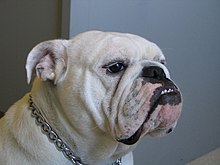Veterinary dentistry involves the application of dental care to animals, encompassing not only the prevention of diseases and maladies of the mouth, but also considers treatment. In the United States, veterinary dentistry is one of 20 veterinary specialties recognized by the American Veterinary Medical Association.[1]




Among other services, veterinary dentists perform endodontics, oral radiographs, and cosmetic and medically indicated surgeries. They address various conditions such as jaw fractures, malocclusions of the teeth, oral cancer, periodontal disease, and unique veterinary conditions like feline odontoclastic resorptive lesions.
Additionally, some animals have specialized dental workers like equine dental technicians, who perform routine dental work on horses.
Oral disease
editPeriodontal disease
editConsequences of periodontal disease
editGingivitis
editSigns and symptoms of oral disease
editThe main signs of oral disease include :
Diagnosis
editRadiography
editOral abnormalities, anomalies, and defects
editMalocclusions
editClass I malocclusion (MAL/1)
editClass II malocclusion (MAL/2)
editClass III malocclusion (MAL/3)
editOther malocclusions
editOral lesions and masses
editMalignant tumors
editNonmalignant tumors
editResorptive lesions
editDevelopmental conditions
editDental cleaning
editDental instruments
editHand instruments
editPower instruments
editDental charting
editSee also
editReferences
edit- ^ "Veterinary Specialty Organizations". Archived from the original on May 1, 2006. Retrieved August 20, 2006.
External links
editOrganizations:
- Academy of Veterinary Dental Technicians
- Academy of Veterinary Dentistry
- American Society of Veterinary Dental Technicians
- American Veterinary Dental College
- American Veterinary Dental Society
- British Veterinary Dental Association
- European Veterinary Dental College
- European Veterinary Dental Society
- Veterinary Oral Health Council
- WikiVet Dentistry
Guidelines: